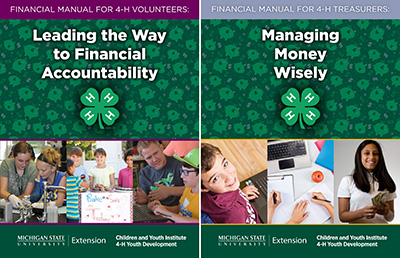What is an Annual Financial Summary Report?
The Annual Financial Summary Report documents the financial activities of a 4-H group during the 4-H program year. Submitting the completed report is required of every 4-H group whether or not they handle money.

This is the first of two articles about the Annual Financial Summary Report. This article addresses what the report is, why it is required and who needs to complete it. The second article, "How do I complete an Annual Financial Summary Report?," provides an overview of the instructions for completing the report.
The Annual Financial Summary Report is an important document in the financial paperwork of a 4-H group. It officially records the income, expenses and inventory of the group as well as determines if the group is required to remit state sales tax. The report provides an open, auditable, public record that provides transparency; it is wise fiscal practice.
Remembering that all funds raised in the name of 4-H are public monies, it is a group’s annual responsibility to complete the Annual Financial Summary Report and submit it to 4-H staff at the end of the program year. Every 4-H group that uses the 4-H name and emblem must complete and submit a copy of the Annual Financial Summary Report. The only exception is 4-H SPIN clubs, which instead complete the 4-H SPIN Club Record of Finances.
It is important to understand the report is required whether or not the group handles money during the year. Thus, even 4-H groups who do not maintain a treasury and do not pass their members’ 4-H participation fees through the group must complete the form. In this case, the person completing the form will need to provide the group information, insert zeros in the income and expense boxes, sign verifying the group doesn’t have an account at a financial institution, list any inventory the group owns and sign the form at the bottom.
The Annual Financial Summary Report must be submitted to the 4-H program coordinator on a date identified by staff. The reports are reviewed by county 4-H staff. Collectively, the Annual Financial Summary Reports from all the 4-H groups in the county are used in the 4-H audit portion of the intermittent Michigan State University Extension office audit process. In addition, the Annual Financial Summary Report provides 4-H staff with the information needed to complete the required annual IRS Form 990. In this way, the Annual Financial Summary Report completes a federal requirement and helps MSU fulfill its obligation of fiscal accountability to the residents of Michigan.
So what happens when a group fails to submit the Annual Financial Summary Report? Since this is in violation of the federal law governing 4-H groups, the group risks being closed down. The group would not be able to operate or provide programming until the report is submitted and reviewed.
 Since the Annual Financial Summary Report keeps track of public money raised in the name of 4-H, it is crucial for all group leaders to understand the significance of this document. Two publications, “Financial Manual for 4-H Volunteers: Leading the Way to Financial Accountability” and “Financial Manual for 4-H Treasurers: Managing Money Wisely,” provide guidance when completing the Annual Financial Summary Report. Both documents include a blank copy of the Annual Financial Summary Report, step-by-step instructions and a sample completed copy. Read the companion article, “How do I complete an Annual Financial Summary Report?,” which explains how to complete the Annual Financial Summary Report.
Since the Annual Financial Summary Report keeps track of public money raised in the name of 4-H, it is crucial for all group leaders to understand the significance of this document. Two publications, “Financial Manual for 4-H Volunteers: Leading the Way to Financial Accountability” and “Financial Manual for 4-H Treasurers: Managing Money Wisely,” provide guidance when completing the Annual Financial Summary Report. Both documents include a blank copy of the Annual Financial Summary Report, step-by-step instructions and a sample completed copy. Read the companion article, “How do I complete an Annual Financial Summary Report?,” which explains how to complete the Annual Financial Summary Report.
Michigan 4-H Youth Development prepares young people for successful futures. As a result of career exploration and workforce preparation activities, thousands of Michigan youth are better equipped to make important decisions about their professional future, ready to contribute to the workforce and able to take fiscal responsibility in their personal lives. To learn about the positive impact of Michigan 4-H youth career preparation, money management and entrepreneurship programs, read the 2015 Impact Report: “Preparing Michigan Youth for Future Careers and Employment.”



 Print
Print Email
Email





